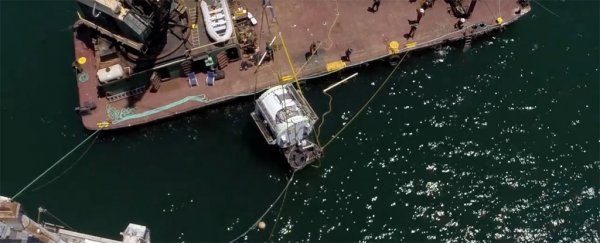The massive data centres that bring you your daily Internet comprise countless racks of servers that generate massive amounts of heat. Companies like Google and Facebook are always on the lookout for the best and most cost-effective cooling solutions to keep these computer arrays from getting too hot, and Microsoft may have just discovered one of the most inspired solutions yet.
Project Natick is an experimental trial to see how data centres perform when they're underwater. It might sound like something out of a Jules Verne novel, but Microsoft is totally serious about the idea, having looked into the feasibility of its 'subsea' servers since 2013.
According to Microsoft, with some 50 percent of the world's population living within 200 kilometres of the sea, underwater data centres that can be readily deployed to coastal environments make more sense than land-based facilities located much further away.
How come? Latency. The closer you are to the servers that house your email, online apps and other cloud services, the quicker you'll be able to get your data, which Microsoft says will help with responsiveness at its customers' end.
Plus, in the future it could be theoretically easier to deploy long-term, but nonetheless temporary, systems housed in pressurised tanks – like the one you can see in the image above – than it would be to build the massive, land-hogging data centres that tech companies traditionally use.
Microsoft says submersible systems could provide rapid response in about 90 days, depending on market demand, for things like natural disasters or special events like the World Cup.
With these considerations in mind, the company submerged its experimental prototype vessel – called the Leona Philpot, after a character in the video game Halo – about 1 kilometre off the Pacific coast of the US last August, where it operated at a depth of about 9 metres (30 feet) until November.
The submersible data centre, housed in a sealed steel capsule about 2.5 metres (8 feet) in diameter, is now back on terra firma (barnacles included) and is being analysed by Microsoft after its aquatic tour of duty.
Initially Microsoft researchers were concerned about the possibility of hardware failures and water leaks, but the prototype seemed to go just fine on the ocean floor. While the initial experiment lasted only a matter of months, Microsoft envisions its submersible data centres could last up to 20 years if the project takes off commercially, with hardware being replaced every 5 years.
Another goal for the project is environmental sustainability. The Leona Philpot was cooled by pressurised nitrogen, but future servers might also be cooled by ocean water, and Microsoft says electricity to run the systems could be provided by co-located offshore power generation facilities.
The next steps for the researchers are to build a new data centre vessel three times larger than the Leona Philpot, which is expected to be trialled next year.
"It's not like a 'moonshot' in the sense that it's just some outlandish thing," says Spencer Fowers, one of the research engineers behind the project, in the video below. "It's actually a viable product that we can make."
